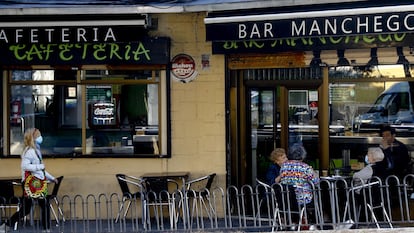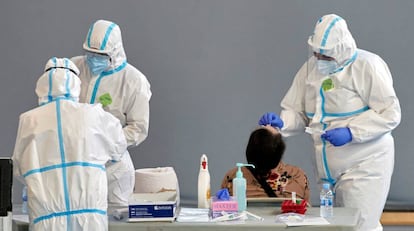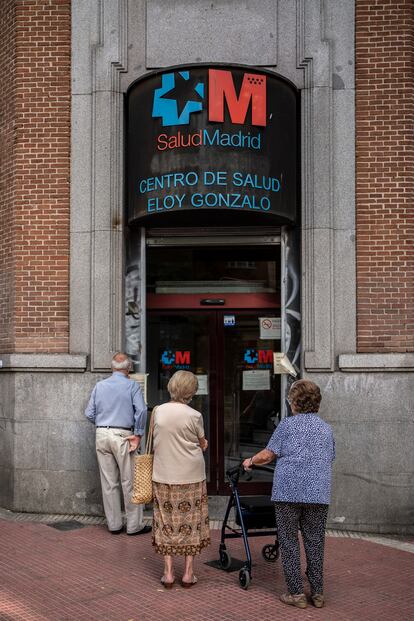Why has Spain failed to contain the coronavirus pandemic?
Experts blame the surge in Covid-19 cases on overconfidence, lack of resources and planning mistakes in the deescalation process

In early July, Spanish Prime Pedro Sánchez claimed: “We have defeated the virus, controlled the pandemic and flattened the curve.” But just a little over two-and-a-half months later, Health Minister Salvador Illa warned: “Madrid is facing tough weeks ahead.”
The so-called new normality, which Spain entered after the end of the state of alarm on June 21, has lasted less than three months. The coronavirus restrictions that were lifted on that date have slowly come back in different regions across the country. On August 18, all nightclubs in Spain were ordered to close and restrictions were introduced on smoking in public spaces. Since then, new measures have been gradually introduced in more areas, with home confinement once again considered a real possibility, if it has not already been implemented.
This is a story of failure. Spain only managed to stop having the worst coronavirus incidence in Europe between the last weeks of spring and the first of summer. Today, once again, it has the highest transmission rates on the continent, with figures far higher than any of its neighbors. So what happened during this time?
We should have had a more solid plan to lift the confinement measuresHealth expert Rafael Bengoa
To answer this question, one has to go back to the state of alarm and the deescalation plan. Several experts agree that Spain had a model strategy. Under the national plan, restrictions would be lifted in an asymmetrical way as regions reduced their Covid-19 incidence rates and showed they had the capacity to effectively control the pandemic if a new wave should hit.
But there were two big problems with the plan: the Health Ministry did not specify what the incidence rate should be, nor what specific healthcare guarantees needed to be in place. In other words, there were no clear parameters to follow. What’s more, many regions moved to a new phase of the deescalation plan when they shouldn’t have. The Madrid region, for instance, entered Phase 2 promising to strengthen its epidemiological monitoring capacity – a promise that it never fulfilled. Madrid then jumped directly into the new normality, with the state of alarm ending before all regions had passed through every stage of the deescalation plan.
Miguel Hernán, a professor of epidemiology at Harvard University and one of the experts who worked to set the criteria for the phase changes, explains: “The new normality was something else. What we have seen is simply a rushed deescalation without the homework being done.” In his opinion, Spain needed to have met four conditions before easing restrictions under the new normality. First, regional authorities should have proven their ability to create and strengthen both primary healthcare and diagnosis of coronavirus cases, as well as contact tracing and quarantine measures. Secondly, the Spanish government needed to have defined transparent and common epidemiological indicators to facilitate joint action. Thirdly, multidisciplinary experts, including specialists in epidemiology and the economy, should have designed concrete measures for the deescalation plan in order to combine sustainable economic activity with the available science on the coronavirus. And lastly, there needed to be an ongoing decision-making process to either lift or introduce new restrictions based on an analysis of the epidemiological data from the previous three weeks.

Miquel Porta, a professor in epidemiology, preventive medicine and public health, believes the failure of the new normality dates back to even before the pandemic began. “It wasn’t the lack of criteria for the deescalation that failed, but rather the application of these criteria,” he says, blaming this problem on the “inability of the state.” “It is not even a problem of politicians, but rather of the machinery of the state,” he explains. Porta points out that Spain still does not have a Public Health Agency, which he and his colleagues have been requesting for years. “Our [public health and epidemiological services] work as if we were still in the 19th century,” he says. “It’s like doing accounting with an abacus.”
The closest thing Spain has to a Public Health Agency is the Coordination Center for Health Alerts and Emergencies (CCAES), a Health Ministry department with fewer than a dozen workers who were quickly overwhelmed by the crisis. More worrying yet, Spain still does not even have a system that is able to collect data in a timely and orderly fashion. At least not completely.
Lack of contact tracers
Spain also does not have enough contact tracers or primary healthcare capacity: these vital measures for containing the second wave of the pandemic are far below the European average. This, combined with some citizens’ relaxed attitude towards safety measures, the fact that some companies did not do enough to protect their workers; the stubborn refusal to close down nighttime venues; and, according to experts, a certain element of randomness, have led to a surge in coronavirus cases and the introduction of new restrictions and lockdowns.
The CCAES published a plan that was negotiated with regional authorities, aimed at addressing outbreaks quickly before they led to community transmission of the virus. But the document, titled An early response plan to control the Covid-19 pandemic, approved on July 16, when hundreds of seasonal workers had already contracted the disease in the Aragón region, appears to have had little success. The plan outlined what measures should be taken in three different scenarios. But once again it did not set any numerical criteria. It did not establish a threshold for closing nighttime venues, restricting social activities or confining neighborhoods.

Two months later, the central government and Madrid authorities are battling over whether mobility should be restricted in areas where the 14-day cumulative incidence rate of Covid-19 is more than 500 cases per 100,000 inhabitants, or only in those where it is 1,000. The Madrid government has opted for the latter criteria, while Harvard University puts the limit at 350 cases.
Rafael Bengoa, one of the most respected health experts in Spain, argues that the country has been “excessively biased” toward returning to normal life. “This is reasonable of citizens because after being confined for nearly four months, it’s normal to want to return to normality. But all the governments know this bias is dangerous in any situation. We should have had a more solid plan to lift the confinement measures. All the regions appeared prepared, but now some of them aren’t. And if you add to this the very irregular behavior of citizens, you have a perfect storm,” he explains.
Overconfidence
“Calling it the new normality was probably a mistake, because it made us too confident,” says Saúl Ares, a scientist at the National Biotechnology Center. “While the virus is with us we should be clear about three things: primary healthcare must be strengthened as much as possible at all times; tracers, with cases or without them, should be as many as recommended. And third, even if the incidence rate is low, the population must live with certain social-distancing rules until it passes, avoiding indoor meetings or always wearing a face mask when they happen, as well as following hygiene rules.”
Daniel López Acuña, the former director of emergencies at the World Health Organization (WHO), agrees: “For many people the new normality was the return to normality, and that has been a fundamental mistake: not accepting that we were returning to a point on a curve that had been somewhat flattened but where the virus had not yet disappeared,” he says.
Between now and the arrival of a coronavirus vaccine, it is possible that we will have to drop the ephemeral idea of a new normality. The battle against the virus will last for months more, and there may even be a third wave. To overcome the second wave and prepare for what else may happen, self-evaluation is needed. Bengoa and 19 of his colleagues signed a letter in the medical journal The Lancet calling for an independent review of the government’s response to the crisis aimed at identifying what went wrong and proposing measures so the problems don’t happen again in the event of another pandemic.
“I would not be seeking a new normality,” says Bengoa. “Returning to the political and social normality, to the inequality, is not what should be done.” Together with another group of experts, he is working with the WHO on a document that sets out the long-term conditions to create a more organized and fairer health system that is more respectful of the environment. In other words, the goal is to learn from our mistakes, something that has not always happened in this pandemic.
English version by Melissa Kitson.
Tu suscripción se está usando en otro dispositivo
¿Quieres añadir otro usuario a tu suscripción?
Si continúas leyendo en este dispositivo, no se podrá leer en el otro.
FlechaTu suscripción se está usando en otro dispositivo y solo puedes acceder a EL PAÍS desde un dispositivo a la vez.
Si quieres compartir tu cuenta, cambia tu suscripción a la modalidad Premium, así podrás añadir otro usuario. Cada uno accederá con su propia cuenta de email, lo que os permitirá personalizar vuestra experiencia en EL PAÍS.
¿Tienes una suscripción de empresa? Accede aquí para contratar más cuentas.
En el caso de no saber quién está usando tu cuenta, te recomendamos cambiar tu contraseña aquí.
Si decides continuar compartiendo tu cuenta, este mensaje se mostrará en tu dispositivo y en el de la otra persona que está usando tu cuenta de forma indefinida, afectando a tu experiencia de lectura. Puedes consultar aquí los términos y condiciones de la suscripción digital.
Últimas noticias
Maduro pleads not guilty before the federal court in New York: ‘I am still the president of Venezuela’
A new test can detect Alzheimer’s from a finger prick
UN team enters Sudanese city of El Fasher after paramilitary massacre: ‘It’s like a ghost town’
A recipe for resistance: Indigenous peoples politicize their struggles from the kitchen
Most viewed
- Gilles Lipovetsky: ‘If you want to live better and fall in love, take Prozac, don’t look to philosophy’
- Alain Aspect, Nobel laureate in physics: ‘Einstein was so smart that he would have had to recognize quantum entanglement’
- Alvin Hellerstein, a 92-year-old judge appointed by Bill Clinton, to preside over Maduro’s trial in New York
- Maduro’s downfall puts China’s relationship with Venezuela to the test
- Why oil has been at the center of Venezuela-US conflicts for decades









































